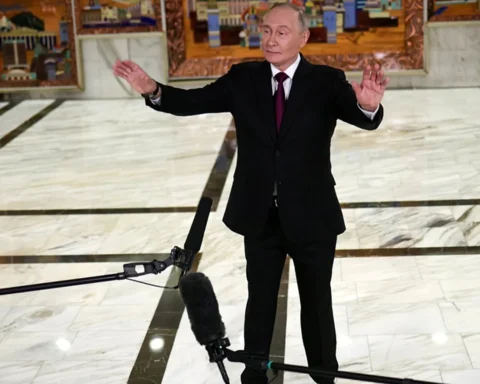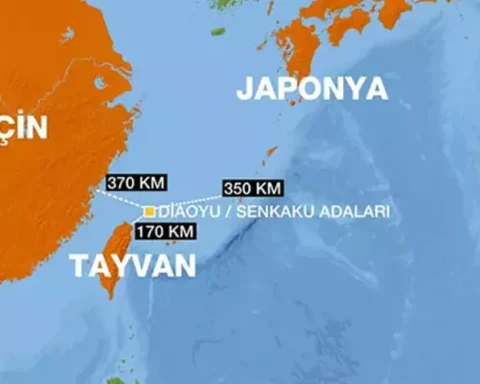Why Sanctions Relief Is Not Enough
During his trip to the Middle East in mid-May, U.S. President Donald Trump did something extraordinary. On the Saudi leg of his four-day tour, the president issued a sweeping change to U.S. policy toward Syria. First, he announced, to riotous applause in Riyadh, that the United States would suspend all sanctions on the country as the Syrian government navigates a difficult transition following the collapse of the Bashar al-Assad regime in December. The following day, Trump met publicly with Syria’s interim president, Ahmed al-Shara, a former al-Qaeda fighter who just months ago had a $10 million U.S. government bounty on his head. After the meeting, Trump referred to Shara as a young, attractive guy with a “strong past.”
In taking these abrupt steps, Trump skirted what in any other U.S. administration would likely have been a long and tedious policymaking process. For months, many Syrians and Syria watchers had worried that the United States might never lift its sanctions. Washington first imposed sanctions on Syria in 1979, when it declared its regime to be a state sponsor of terrorism, triggering a ban on arms sales and other restrictions on exports to the country. Congress imposed additional sanctions in the early years of the twenty-first century. After Syria’s civil war began in 2011, both the United States and Europe added further restrictions. Armed groups within Syria—some of which are now represented in the government in Damascus—were also issued terrorist designations and therefore remain subject to sanctions. Together, these measures largely cut Syria off from international trade and investment and have been a major barrier to economic recovery in the war-ravaged country.
Syria’s need is urgent. More than 90 percent of Syrians live below the poverty line, and 70 percent require humanitarian aid to meet basic needs. At the current rate of growth, it would take Syria’s economy until at least 2080 to reach the GDP it had before the civil war began in 2011. Dire economic conditions are worsened by the communal violence and sectarian tensions that have flared since the fall of the Assad regime, which was dominated by the Alawite minority, and the seizure of the capital predominantly by Shara’s Hayat Tahrir al-Sham (HTS), a Sunni-affiliated former rebel group. Shara has promised to protect Syria’s minorities, but some members of the Alawite, Druze, and other communities are not convinced. External interference, including from Israel, which has launched over 700 strikes on Syria and seized territory within the country, has deepened the country’s instability. All these pressures are now mounting. Days after Trump’s announcement, U.S. Secretary of State Marco Rubio told the Senate Foreign Relations Committee that the decision to lift sanctions came after U.S. officials concluded that that Syria’s transitional government could be “weeks, not many months, away from potential collapse and a full-scale civil war of epic proportions.”
Trump’s unexpected pivot on sanctions was the right thing to do, and it could help Syria address its current challenges. The toppling of the brutal Assad regime opened the door to a better future for Syrians and for the region. But removing sanctions was never going to be enough to pull the country away from the brink. Beginning to lift U.S. sanctions is an important first step—one that has been amplified by the European Union’s decision to lift most of its own sanctions on Syria—to create favorable conditions for the foreign investment Syria desperately needs. The United States and Syria’s other partners now need to clear the remaining obstacles to stability and economic recovery, and do so quickly—rather than let internal pressures and regional rivalries cause the country to unravel.
ECONOMIC OPPORTUNITY
The Trump administration has already taken some steps to fulfill the president’s promise to remove sanctions. Last week, the Treasury Department’s Office of Foreign Assets Control issued a license that immediately lifts most U.S. sanctions, including those on Shara himself, although it does not remove foreign terrorism designations and can be rescinded at any time. On the same day, the State Department issued a 180-day waiver of sanctions imposed under the 2019 Caesar Act, which will enable foreign governments, businesses, and individuals to do business in Syria.
Waivers, however, are only a partial solution. Without a permanent removal of sanctions, which in the case of Caesar Act sanctions will require congressional approval, uncertainty about whether sanctions will simply return in six months could hinder Syria’s economic recovery. Some investors that are close to the Trump administration or accustomed to working in sanctioned economies may not be deterred. But many international companies and firms looking for long-term ventures may still hesitate to invest. They could choose to play it safe and avoid doing business in Syria altogether, as many have done throughout the country’s civil war.
Removing sanctions alone was never going to pull Syria away from the brink.
There is more that the Trump administration can do. The State Department can work toward de-classifying HTS as a foreign terrorist organization, which would require determining that the original conditions for the designation are no longer applicable or that there are national security reasons for removing it. The department should similarly aim to remove Syria’s designation as a state sponsor of terror, on the basis of a fundamental change in the country’s leadership and policies, along with assurances from the current leadership that it is not supporting terrorism now, nor will it in the future. Without these designation removals, relaxing export controls will likely be difficult.
For now, sanctions relief is already enabling Gulf countries and other actors to invest in Syria. Three days after Trump’s sanctions announcement, an Emirati company signed an $800 million memorandum of understanding with the interim government in Damascus to develop the Syrian port of Tartus and establish industrial and free trade zones. Qatar and Saudi Arabia have already paid Syria’s debt, allowing the country to secure loans and cash infusions from international financial institutions, such as the World Bank. Syria can also be reintegrated into the global financial system. For example, reentering the SWIFT system—which is vital for sending money between banks, international wire transfers, and other payments—would facilitate remittances and other international transactions.
Under the Assad regime, the Syrian economy barely stayed afloat, propped up by Iran and Russia, drug trafficking, and humanitarian aid. Lifting sanctions would allow reconstruction to begin in earnest. Syria’s oil and gas, raw materials, and manufacturing sectors could be revived, generating revenue for the government and providing livelihoods for many of the country’s citizens. The energy sector in particular needs investment; Syria produced nearly 400,000 barrels of oil per day in 2010, before the civil war, but by the time Assad fell last year, that output had fallen to 40,000 to 80,000 barrels per day. On the individual level, sanctions relief will help Syrians living abroad invest in their country by making it easier to send money home. None of this progress is guaranteed—not all reconstruction efforts will be attractive to investors, and the shutdown of the U.S. Agency for International Development by the Trump administration leaves a large gap that other funders will need to fill. But sanctions relief gives Syria options beyond depending on other sanctioned countries and illicit activities to survive.
REGIONAL RIVALS
Sanctions are not the only obstacle threatening to destabilize Syria. Since the ouster of the Assad regime, a competition has emerged to gain economic and political advantage in the weakened country. One of the main players is Israel. The Israeli military has launched hundreds of strikes into Syria and occupied parts of southern Syria, and the Israeli government has stoked sectarian division by claiming that the incursion is an attempt to protect the Druze minority. Israel has also lobbied the United States to maintain sanctions on Syria and allow Russia to keep its military bases in the country. The United Arab Emirates has been mediating secret talks between Israel and Syria, and Shara has said repeatedly that he does not want a war with Israel. The Syrian government even returned the belongings of the Israeli spy Eli Cohen, who was executed in Damascus in 1965 after his espionage was discovered, in a goodwill gesture. But Israeli occupation of Syrian territory continues. The Trump administration’s outreach to Shara does seem to have softened Israel’s stance, as Israeli airstrikes on the country have subsided in the days since. Now, the U.S. president should further wield his leverage to rein in Israel’s disruptive operations.
Other regional actors have jumped into the fray, too, looking to ink investment deals with the new Syrian government that may or may not serve the country’s long term-interests. In December, for example, Turkey announced a plan to negotiate an exclusive economic zone agreement with Syria that would define maritime boundaries to give each country exclusive rights to explore and exploit resources, including oil and gas, within its own zone. There may be an economic benefit for Syria in such an accord, but it would also inflame disputes over existing maritime boundaries in the eastern Mediterranean, putting Syria in conflict with its neighbors.
There are ways that Turkey can play a more constructive role. The Syrian government, free of sanctions, could work with Ankara on its plans to build an energy transit infrastructure connecting the Levant, the Gulf, and potentially Europe. Turkish assistance to the Syrian military could deter attacks by foreign militaries or the so-called Islamic State, as long as that support does not compromise Syria’s independence or aggravate the security concerns of other actors, particularly Israel.
An Israeli-Turkish clash in Syria is a troubling possibility. In March, an Israeli news outlet reported that the Israeli government was preparing for the possibility of such a confrontation. More recently, Israel and Turkey have engaged in talks to dial down tensions and establish a hotline for that purpose in Syria. Yet as the Syrian government and its security forces rebuild, Israel and Turkey could vie for influence over that process in ways short of direct military confrontation. The U.S. government has likely already pushed Israel to step back by engaging with the interim Syrian authorities, the Gulf states, and Turkey itself. But continued U.S. diplomacy can help ensure that Syria does not once again become a playground for regional rivalries.
For Syria to take charge of its own defense, including conducting its own counterterrorism operations, it will need the economic resources and international assistance to reconstruct and unite its military and security services. Right now, the security situation is tenuous. HTS does not control all areas of the country and has trouble commanding some of the fighters within its ranks. It has even less of a hold on other forces, such as the tens of thousands of fighters in the Free Syrian Army, which takes more direction from Ankara than from Damascus. Militias composed of former Assad regime elements have regrouped on Syria’s coast, and the Islamic State is resurging in the east. Some Kurdish and Druze armed groups have not given up on the prospect of autonomy in a post-Assad Syria. Managing this fractured security environment will be difficult without external support, including training on mitigating harm to civilians. The challenge will be to build disciplined security and police forces that protect, rather than extort from, the Syrian people. Syrians are glad to be rid of the Assad regime’s checkpoints, set up to monitor citizens and demand bribes—but they also fear a return to corruption and violence should the country’s economic recovery falter.
GOOD GOVERNANCE
Those fears are not baseless. Syria is surrounded by cautionary tales of post-conflict mismanagement. Corruption became entrenched in Iraq during the reconstruction process that followed the U.S. invasion in 2003, and in Lebanon after the end of the 1975–90 civil war there. A handful of politicians and businesses grew wealthy at the expense of basic services and economic development for the broader populations. The failure of transitional governments to develop integrated economies led to growing sectarian conflict and left vacuums for nonstate actors to fill. Iraq is still struggling to diversify its oil-dependent economy and promote sustainable development in its agriculture and energy sectors, in large part because of endemic corruption and the interference of Iran and nonstate groups in the Iraqi economy. Likewise, the productive sectors of the Lebanese economy faltered as dependence on cheap imports increased in the postwar era. Warlords turned politicians pursued infrastructure projects that benefited them personally rather than fostering broad-based growth.
Past experience with post-conflict reconstruction around the world shows that transparency and inclusivity in government decision-making are the best antidotes to corruption, economic stagnation, and other common maladies in recovering countries. So far, however, Washington’s demands of the new Syrian government have been limited to security-related matters, such as the expulsion of foreign militants, and have neglected the political and institutional reforms needed to ensure a peaceful transition.
Syria is surrounded by cautionary tales of post-conflict mismanagement.
This is a mistake. The aspirations that Syrians fought and died for must not be overlooked. Facing no pressure from the United States—or from governments in the region that fear a successful democratic movement in Syria that could inspire unrest in their own countries—Shara has consolidated power. But if the Syrian government ignores the will of Syrians who rose up against Assad’s authoritarianism, it risks reigniting conflict and reviving nefarious forces such as the Islamic State.
What happens in Syria could affect stability well beyond its borders. Beginning in 2011, the Syrian civil war displaced millions of people, creating a wave of refugees on Europe’s borders. One result was the rise of far-right parties across Europe, which took advantage of a popular backlash against migrants to draw a surge of electoral support. The Iranian government, meanwhile, exploited the Assad regime’s weakness to strengthen its influence across Iraq, Syria, and Lebanon, destabilizing those countries and strengthening armed nonstate groups. Syria’s pariah status under the Assad regime also made it impossible to take meaningful steps toward regional integration, from negotiating trade deals to building new gas pipelines.
Rather than repeating that history, Syria’s post-Assad transition could be a catalyst for growth and stabilization. When Trump announced that he was ending U.S. sanctions, he said that the move gave Syrians “a chance at greatness.” To keep that chance alive, his administration must build on the current momentum and ensure that the U.S. government follows through on his promise—and that actors in Syria and across the region do not spoil the process. Lifting sanctions was the first pivotal step toward a stable, fruitful post-Assad transition in Syria. It must certainly not be the last.
*NATASHA HALL is a Senior Fellow with the Middle East Program at the Center for Strategic and International Studies.
**NINAR FAWAL is a Program Manager and Research Associate for the Middle East Program at the Center for Strategic and International Studies.
Source: https://www.foreignaffairs.com/syria/can-syria-recover#






